2020 Survey of Tourism Establishments in the Philippines (STEP) - Economy-Wide: Preliminary Results

This Special Release highlights the preliminary results of the 2020 Survey of Tourism Establishments in the Philippines (STEP) for tourism characteristic industries classified according to the 2016 Philippine Tourism Statistical Classification System (PTSCS).
Number of establishments in the tourism characteristic industries increased by 5.5 percent
The preliminary results of the 2020 Survey of Tourism Establishments in the Philippines (STEP) showed that a total of 40,815 establishments in the formal sector of the economy were engaged in tourism characteristic activities. This was higher by 5.5 percent compared with the 38,699 recorded tourism characteristic establishments in 2014. (Table A)
Among the tourism characteristic industries, food and beverage serving activities recorded the highest share to the total number of establishments at
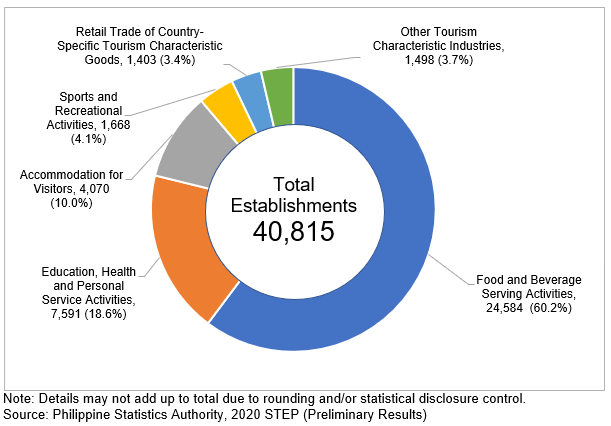
Food and beverage serving activities hired the highest number of workers
A total of 672,947 workers were engaged in tourism characteristic activities in 2020. This represents a decrease of -12.6 percent compared with the reported 770,202 workers in 2014. (Table A)
By tourism characteristic industry, food and beverage serving activities hired the highest number of workers of 275,715 or 41.0 percent of the total. This was followed by education, health and personal service activities with 214,675 workers or 31.9 percent. Far behind was accommodation for visitors with
Figure 2. Distribution of Employment by Tourism Characteristic Industry:
Philippines, 2020
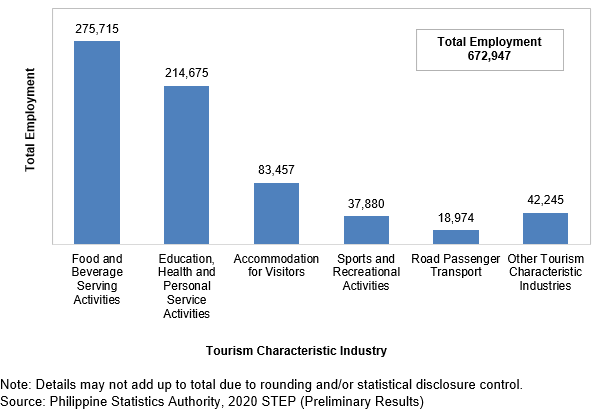
Food and beverage serving activities reported the biggest share to revenue generated from tourists
The total revenue generated from tourists in 2020 amounted to PhP 360.96 billion. Compared with the total revenue generated from tourists in 2014, this reflects a decrease of -26.2 percent. (Table A)
The top three industries in terms of revenue generated from tourists in 2020 were as follows:
1. Food and beverage serving activities with PhP 188.45 billion (52.2%);
2. Air passenger transport with PhP 58.87 billion (16.3%); and
3. Accommodation for visitors with PhP 40.45 billion (11.2%). (Table 1 and Figure 3).
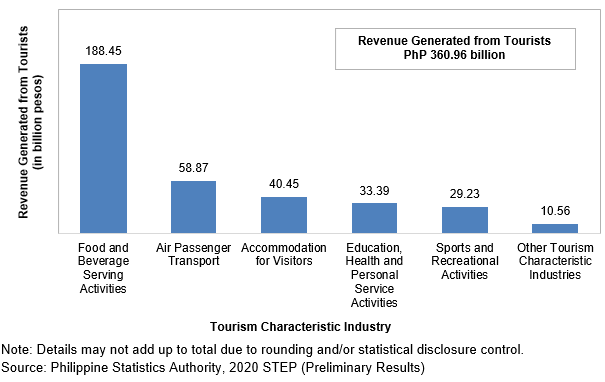
About 6.1 percent of the establishments planned to expand and 8.2 percent planned to renovate within the next five years
Of the total 40,815 tourism characteristic establishments registered in 2020, 6.1 percent planned to expand their business operations within the next five years. This was lower by 4.5 percentage points from the 2014 proportion of 10.6 percent.
Meanwhile, the proportion of establishments with plan to renovate within the next five years was 8.2 percent, lower by 7.7 percentage points from the
Listed below are the top tourism characteristic industries relative to their expansion and renovation plans within the next five years:
1. Food and beverage serving activities with 47.6 percent of the establishments with expansion plan and 41.0 percent with plan to renovate;
2. Education, health and personal service activities with 23.0 percent of the establishments with plan to expand and 21.9 percent with plan to renovate; and
3. Accommodation for visitors with 15.4 percent of the establishments with expansion plan and 20.5 percent with plan to renovate. (Table 1 and Figure 4)
Philippines, 2020
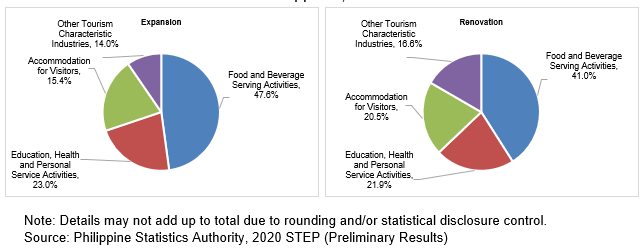
Solid waste generated from tourism characteristic industries totaled to 67.55 million kilograms in 2020
More than 95.0 percent of the total solid waste disposed by tourism characteristics industries in 2020 were generated by three out of the 12 tourism characteristics industries. These three industries with highest solid waste disposal in 2020 were food and beverage serving activities with 49.5 percent share, followed by education, health and personal service activities, and accommodation for visitors with 25.4 percent and 20.2 percent share, respectively. (Table 1)
Air passenger transport recorded the highest proportion of establishments with DOT accreditation
About 27.0 percent of the total tourism characteristics establishments reported in 2020 were accredited by the Department of Tourism (DOT). This was higher by 3.1 percentage points than the reported proportion of 23.6 percent in 2014. (Table A)
DIVINA GRACIA L. DEL PRADO, Ph.D.
(Assistant National Statistician)
Officer-in-Charge, Deputy National Statistician
Sectoral Statistics Office
TECHNICAL NOTES
I. Introduction
This Special Release presents the preliminary results of the 2020 Survey of Tourism Establishments in the Philippines (STEP).
The 2020 STEP is the third survey conducted on tourism establishments in the Philippines. It is a rider to the 2020 Annual Survey of Philippine Business and Industry (ASPBI). Data collected from the survey provide information on the availability of supply of tourism goods, products and services, which are valuable inputs in the compilation of the Philippine Tourism Satellite Account (PTSA).
The conduct of the 2020 STEP is authorized under Republic Act 10625 known as the Philippine Statistical Act of 2013, which mandates reorganizing and strengthening of the Philippine Statistical System (PSS), its agencies and instrumentalities.
II. Data Collection and Processing
The survey was conducted nationwide in 2021 with the year 2020 as the reference period of data, except for employment which is as of 15 November 2020.
Sample establishments were given various options in accomplishing the survey questionnaire. These were the following:
• online questionnaire available at https://step.psa.gov.ph;
• electronic copy of the questionnaire either in portable document format (.pdf) or Excel (.xlsx) file format; and
• printed copy of the questionnaire.
The Establishment Data Management System (EDMS) was utilized in the decentralized processing of 2020 STEP questionnaires in the provinces.
Data are presented by tourism characteristic industries classified according to the 2016 Philippine Tourism Statistical Classification System (PTSCS).
III. Taxonomy of Establishments
An establishment is defined as an economic unit under a single ownership or control which engages in one or predominantly one kind of economic activity at a single fixed location.
An establishment is categorized by its economic organization, legal organization, industrial classification, employment size, and geographic location.
Economic Organization refers to the organizational structure or role of the establishment in the organization. An establishment may be single establishment, branch, establishment and main office with branches elsewhere, main office only, and ancillary unit other than main office.
Legal Organization refers to the legal form of the economic entity, which owns the establishment. An establishment may be single proprietorship, partnership, government corporation, stock corporation, non-stock corporation, or cooperative.
Industrial Classification of an economic unit was determined by the activity from which it derives its major income or revenue. The 2009 PSIC, which was approved for adoption by government agencies and instrumentalities through PSA Resolution No. 01 Series of 2017-158 signed on 14 February 2017 was utilized to classify economic units according to their economic activities.
Size of an establishment is determined by its total employment as of the time of visit during the latest Updating of the List of Establishments.
Total Employment (TE) refers to the total number of persons who work in or for the establishment. This includes paid employees, working owners, unpaid workers and all employees who work full-time or part-time including seasonal workers. Also included are persons on short-term leave such as those on sick, vacation or annual leaves and on strike.
Geographic Classification refers to the grouping of establishments by geographic area using the Philippine Standard Geographic Code (PSGC) classification. The PSGC contains the latest updates on the official number of regions, provinces, cities, municipalities, and barangays in the Philippines. The PSGC as of
IV. Scope and Coverage
The 2020 STEP was a nationwide undertaking and covered tourism characteristic industries classified according to the 2016 Philippine Tourism Statistical Classification System (PTSCS) as defined in Table 1.
Table 1. Scope and Coverage of the 2020 STEP




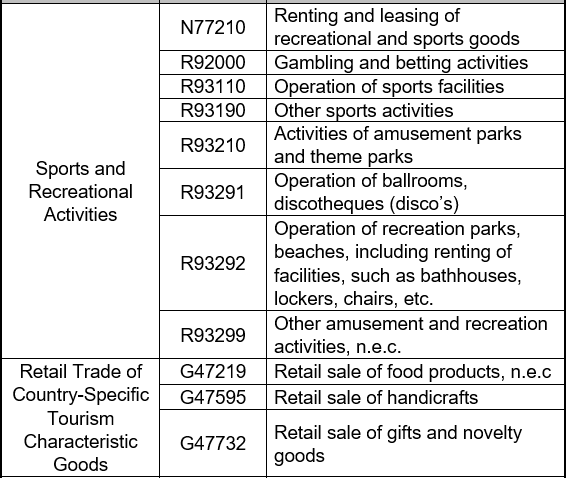

The survey was confined to the formal sector of the economy, which consists of the following:
• Corporations and partnership
• Cooperatives and foundations
• Single proprietorship with employment of 10 and over; and
• Single proprietorships with branches
Hence, the 2020 STEP covered only the following economic units:
All establishments with total employment (TE) of 10 or more, and;
• All establishments with TE of less than 10, except those establishments with Legal Organization = 1 (single proprietorship) and Economic Organization = 1 (single establishment), that are engaged in economic activities classified according to the 2009 Philippine Standard Industrial Classification (PSIC).
V. Sampling Design
The 2020 STEP uses stratified systematic sampling design with 5-digit PSIC serving as industry strata (industry domain) and the employment size as the second stratification variable.
Stratified systematic sampling is a process of dividing the population into homogeneous groups, called strata, and then selecting independent samples in each stratum systematically. This method ensures that all important subgroups of the population are represented in the sample and increases the precision of “overall” survey estimates.
Domain
The geographic domain of the 2020 STEP is at the national level. The industry domain/stratum is 5-digit industry classification, and the employment domain/stratum is the MSME classification.
Unit of Enumeration
The unit of enumeration for the 2020 STEP is the establishment.
Sampling Frame of Establishments
The frame for the 2020 STEP was the list of samples of the 2020 ASPBI, which was extracted from the preliminary 2020 List of Establishments (LE) as of
Estimation Procedure
By MSME Classification
a. Total Estimate by MSME Classification
The estimate of the total of a characteristic ![]() by MSME classification at the national level is
by MSME classification at the national level is

where:
m denotes the employment stratum based on MSME classification
j 1, 2, 3,…, nm establishments
Xmj value of the jth establishment in the employment stratum based on MSME classification at the national level
Wmj weight of the jth establishment in the employment stratum based on MSME classification at the national level

where:
Nm total number of establishments in the employment stratum based on MSME classification at the national level
nm number of sample establishments in the employment stratum based on MSME classification at the national level
By Industry Domain
a. Non-certainty stratum (All other establishments not classified as MICE)
The estimate of the total of a characteristic ![]() for the non-certainty stratum for an industry domain at the national level is
for the non-certainty stratum for an industry domain at the national level is

where:
g denotes the non-certainty stratum for an industry domain
j 1, 2, 3,…, ng establishments
Xgj value of the jth establishment in the non-certainty employment stratum for an industry domain at the national level
Wgj weight of the jth establishment in the non-certainty employment stratum for an industry domain at the national level

where:
Ng total number of establishments in the non-certainty employment stratum for an industry domain at the national level
ng number of sample establishments in the non-certainty employment stratum for an industry domain at the national level
b. Certainty stratum (Establishments under Meetings, Incentives, Conferences and Exhibitions (MICE) as identified by the Department of Tourism (DOT)
The estimate of the total of a characteristic (Xc) for the certainty stratum in an industry domain at the national level is

where:
c denotes the certainty stratum
j 1, 2, 3, …, hc establishments
Xcj value of the jth establishment in the certainty employment stratum in an industry domain at the national level
hc number of establishments in the certainty employment stratum industry domain within each region
c. Total Estimate by MSME and Industry Domain
National level estimates of the total of a characteristic ![]() for an MSME or industry domain was obtained by aggregating the estimates for all strata (non-certainty and certainty) for MSME and industry domain,
for an MSME or industry domain was obtained by aggregating the estimates for all strata (non-certainty and certainty) for MSME and industry domain,

where d denotes the MSME or industry domain
Weight Adjustment Factor for Non-Response
To account for non-response and non-eligible respondents of the survey, the base weight was multiplied with the adjustment factor for each of the sampling unit. The computation of the weights is as follows.
a. Base Weight

where:
Whj = weight of the jth establishment in the hth stratum
Nh = total no. of establishments belonging to the hth stratum
nh = total no. of sample establishments in the hth stratum
a. Adjustment Factor
To take into account for the non-responding sample establishments and non-eligible respondents, the adjustment factor by region and industry domain is as follows:

where:
As = adjustment factor for industry domain s
X1i = eligibility status of the ith establishment (1 if eligible, 0 otherwise)
X2i = responding status of the ith establishment (1 if responding, 0 otherwise)
b. Final Weights
The final weights is the product of the base weight and adjustment factor. That is,
VI. Response Rate
Response rate for 2020 STEP was 92.7 percent (9,132 out of 9,849 establishments). This included receipts of "good" questionnaires, partially accomplished questionnaires, and reports of closed, moved out or out of scope establishments.
Of the total respondents, 226 establishments responded online.
Reports of establishments which were found to be duplicate of another establishment, out-of-scope and out of business in 2020 were not included in the generation of statistical tables.
VII. Concepts and Definitions of Terms
Accreditation refers to a certification issued by the Department of Tourism, which recognizes the holder to having complied with its minimum standards in the operation of the establishment concerned.
Bed capacity is the maximum number of beds, which can be installed or set up in an assisted living facility at any given time for use of residents.
Booking office is a room where tickets are sold and booked, especially in a theater or station.
Carrier refers to a transportation company, such as an airline, motor coach, cruise line, or railroad, which carries passengers and/or cargo carrying capacity: the amount of tourism a destination can handle.
Carrying capacity is the amount of visitor activity that a site or destination can sustain.
Commission refers to the percentage of selling price paid to a retailer by a supplier. In the travel industry, travel agents receive commissions for selling tour packages or other services.
Computer reservation systems (CRS) are used for inventory management by airlines, hotels and other facilities. CRS can allow direct access through terminals for intermediaries to check availability, make reservations and print tickets.
Composting refers to the controlled decomposition of organic matter by micro-organisms, mainly bacteria and fungi, into a humus-like product.
Contractual employee refers to one employed by a contractor or subcontractor to perform or complete a job, work or service pursuant to an arrangement between the latter and a principal.
Disposal refers to the discharge, deposit, dumping, spilling, leaking or placing of any solid waste into or in any land.
Domestic tourism refers to tourism of resident visitors within the economic territory of the country of reference.
Electronic payment (e.g. Credit card, ATM) refers to money paid electronically. Also known as e-money, electronic cash, electronic currency, digital money, digital cash or digital currency.
Inbound tourism refers to tourism of non-resident visitors within the economic territory of the country of reference.
Non-supervisory employees include any employee who does not have authority to hire, discharge, promote, transfer, suspend, layoff, or discipline other employees or to effectively recommend such action, or who is not in a confidential relationship with management. Determination of non-supervisory and confidential status shall be made by the manager.
Outbound tourism refers to tourism of resident visitors outside the economic territory of the country of reference.
Regular or permanent employment is when an employee performs activities that are usually necessary or desirable in the usual business or trade of the employer.
Seasonal workers are individuals who were hired for a specific period to augment the regular employees due to high demand of clients and/or increased work demands during peak months.
Solid waste includes all discarded household, commercial waste, non-hazardous institutional, ports/harbour and industrial waste, street sweepings, construction debris, agriculture waste, and other non-hazardous/non-toxic solid waste.
Supervisory employee refers to an employee who, in the interest of the employer, effectively recommends managerial actions if the exercise of such authority is not merely routinely or clerical in nature but requires the use of independent judgement,
Tourism refers to activities of foreign and domestic visitors traveling to and staying in places outside their usual environment for not more than one year for leisure, business and other purposes not related to employment with pay from within the place visited. Traveling for the purpose of conducting businesses, for education and training, etc., can also be part of tourism. Both foreign visitors (country of residence is other than the Philippines) and domestic visitors (Philippine residents) are covered in the survey.
Tourist/Visitor refers to a person traveling to a place other than that of his/her usual environment for less than 12 months and whose main purpose of the trip is other than the exercise of an activity remunerated within the place visited.
Tourism activities encompass all that foreign and domestic visitors do for a trip or while on a trip. It is not restricted to what could be considered as “typical” tourism activities such as sightseeing, sunbathing, visiting site, etc. From an economic point of view, the basic activity of foreign and domestic visitors is consumption, that is, the acquisition of consumption goods and services to satisfy individual or collective needs and wants.
Worker displacement is defined as the separation of workers to their jobs or termination of the employment relationship that is involuntary on the part of the worker, with a permanent effect without assurance of re-employment to the same employer or industry, and that is not caused by the worker’s job performance, work behavior and attitude, or work relations and other factors that are not attributable to the characteristics of the individual worker.
